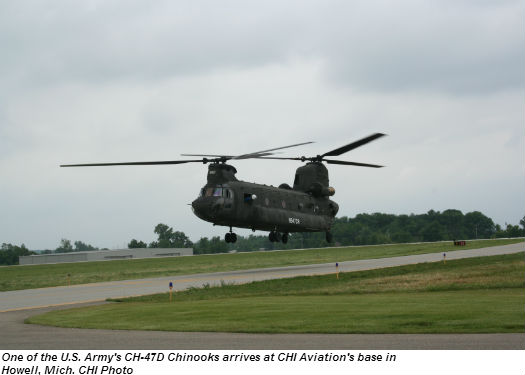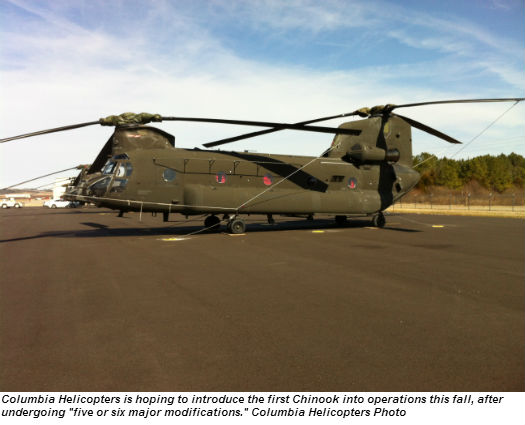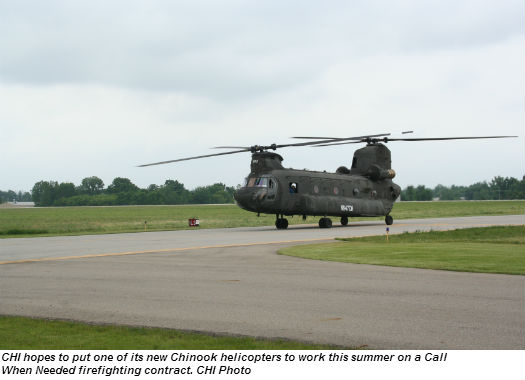
The sight of heavy-lift tandem rotor helicopters performing commercial operations is set to become increasingly common, following the U.S. Army’s decision to auction off a reported 15 CH-47D Chinooks to civilian operators.
So far, 12 of the aircraft have been sold to three operators through online auctions hosted by the General Services Administration (GSA). Columbia Helicopters, which to date had been the only operator of the civilian version of the Chinook — the Boeing 234 — as well as the tandem rotor Boeing Vertol 107-II, has purchased six of the CH-47Ds, while CHI Aviation (formerly known as Construction Helicopters) and Billings Flying Service have each bought three of the aircraft, which have a restricted category type certificate.
The auctions began back in December, with the most recent being completed in early June. Through the sale of the first 10 Chinooks, the Army reportedly recouped $28 million, with prices ranging from $2 million to about $3.5 million per aircraft. The Army said the funds are to be reinvested to offset the costs of new CH-47F Chinooks, while the auction process is said to save approximately $250,000 per aircraft in demilitarization costs the Army would otherwise have incurred.

The Army’s original intent was to auction off just 10 aircraft to the commercial market, but, according to Columbia Helicopters president Stan Wilson, this has been increased to 15 due to demand.
Wilson said the aircraft arrived in “various conditions” and that Columbia is hoping to get the first CH-47D in operation by the fall. “We’d like to get them going as soon as we possibly can,” he said. “We are very safety-conscious, so we are going to do everything we know how to ensure they’re safe and they’re in good service condition.”
In terms of repurposing the aircraft for commercial operations, Wilson said Columbia was looking at “five or six major modifications . . . for the long-term benefit of the aircraft” — but wouldn’t give further details.
“We’re extremely happy to be able to expand our super heavy lift fleet,” said Wilson. “We have been limited in our ability to grow in that sector, and so this is a very significant and positive opportunity for us.”

However, while the auctions have allowed Columbia to boost its Chinook fleet, they have also resulted in the introduction of competitors in the commercial tandem-rotor heavy-lift market for the first time.
“We have no choice but to look forward to the competition and know that it’ll make us sharper,” said Wilson. “We really feel like we have tremendous advantage in terms of experience and hope that we can lever that in ways that can show that we are very capable of being the provider of choice to our end customer.”

CHI Aviation brought its three Chinooks to its base in Howell, Mich., last week, and company president Chris Turner said it hoped to put one to work this summer on a Call When Needed firefighting contract. “The U.S. Forest Service is just as excited as we are to bring the Chinooks out into the firefighting world,” he said.
Turner said modifications would mainly be centered around the avionics, with the existing system needing to be stripped out and replaced, while the ramp will likely be removed and the flight engineer panel brought up to the front. Finally, for long-term firefighting work, the company is looking to create its own tank for the aircraft.
However, the company believes the aircraft will slot in well across its range of heavy-lift operations, with potential opportunities worldwide. “When the government started auctioning them off, it was a perfect fit for us; heavy helicopters are what we do,” said Turner.
According to Mike Jones, CHI Aviation’s director of training and standards, the company isn’t having any difficulty finding the crews to support the new aircraft. “They’re not hard to find, there’s a Chinook [National Guard] unit right here in Michigan,” he said. “There’s pilots and mechanics that are here, and a lot of them think it’s just the greatest thing that [the aircraft] are now out more widely in the civilian market, and they have an opportunity to go out there and fly or work on them.”









